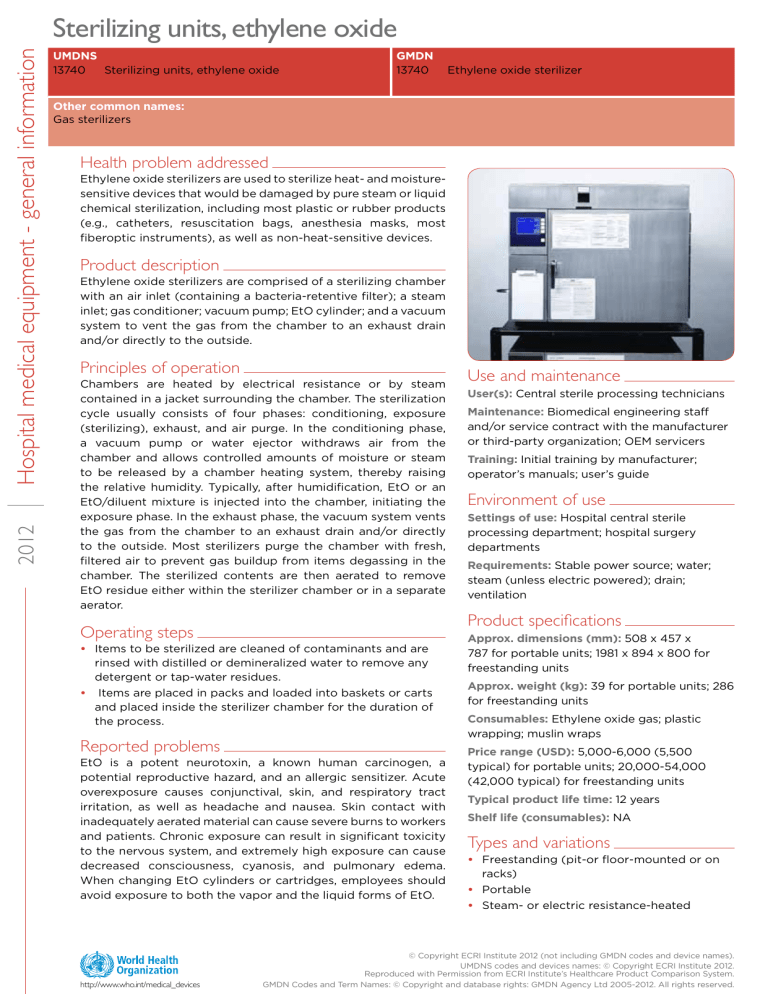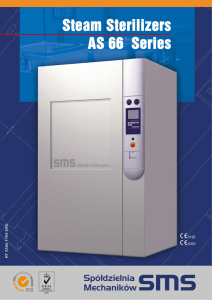Sterilizing units, ethylene oxide

Sterilizing units, ethylene oxide
UMDNS
13740 Sterilizing units, ethylene oxide
GMDN
13740 Ethylene oxide sterilizer
Other common names:
Gas sterilizers
Health problem addressed
Ethylene oxide sterilizers are used to sterilize heat- and moisturesensitive devices that would be damaged by pure steam or liquid chemical sterilization, including most plastic or rubber products
(e.g., catheters, resuscitation bags, anesthesia masks, most fiberoptic instruments), as well as non-heat-sensitive devices.
Product description
Ethylene oxide sterilizers are comprised of a sterilizing chamber with an air inlet (containing a bacteria-retentive filter); a steam inlet; gas conditioner; vacuum pump; EtO cylinder; and a vacuum system to vent the gas from the chamber to an exhaust drain and/or directly to the outside.
Principles of operation
Chambers are heated by electrical resistance or by steam contained in a jacket surrounding the chamber. The sterilization cycle usually consists of four phases: conditioning, exposure
(sterilizing), exhaust, and air purge. In the conditioning phase, a vacuum pump or water ejector withdraws air from the chamber and allows controlled amounts of moisture or steam to be released by a chamber heating system, thereby raising the relative humidity. Typically, after humidification, EtO or an
EtO/diluent mixture is injected into the chamber, initiating the exposure phase. In the exhaust phase, the vacuum system vents the gas from the chamber to an exhaust drain and/or directly to the outside. Most sterilizers purge the chamber with fresh, filtered air to prevent gas buildup from items degassing in the chamber. The sterilized contents are then aerated to remove
EtO residue either within the sterilizer chamber or in a separate aerator.
Operating steps
• Items to be sterilized are cleaned of contaminants and are rinsed with distilled or demineralized water to remove any detergent or tap-water residues.
• Items are placed in packs and loaded into baskets or carts and placed inside the sterilizer chamber for the duration of the process.
Reported problems
EtO is a potent neurotoxin, a known human carcinogen, a potential reproductive hazard, and an allergic sensitizer. Acute overexposure causes conjunctival, skin, and respiratory tract irritation, as well as headache and nausea. Skin contact with inadequately aerated material can cause severe burns to workers and patients. Chronic exposure can result in significant toxicity to the nervous system, and extremely high exposure can cause decreased consciousness, cyanosis, and pulmonary edema.
When changing EtO cylinders or cartridges, employees should avoid exposure to both the vapor and the liquid forms of EtO.
Use and maintenance
User(s): Central sterile processing technicians
Maintenance: Biomedical engineering staff and/or service contract with the manufacturer or third-party organization; OEM servicers
Training: Initial training by manufacturer; operator’s manuals; user’s guide
Environment of use
Settings of use: Hospital central sterile processing department; hospital surgery departments
Requirements: Stable power source; water; steam (unless electric powered); drain; ventilation
Product specifications
Approx. dimensions (mm): 508 x 457 x
787 for portable units; 1981 x 894 x 800 for freestanding units
Approx. weight (kg): 39 for portable units; 286 for freestanding units
Consumables: Ethylene oxide gas; plastic wrapping; muslin wraps
Price range (USD): 5,000-6,000 (5,500 typical) for portable units; 20,000-54,000
(42,000 typical) for freestanding units
Typical product life time: 12 years
Shelf life (consumables): NA
Types and variations
• Freestanding (pit-or floor-mounted or on racks)
• Portable
• Steam- or electric resistance-heated
© Copyright ECRI Institute 2012 (not including GMDN codes and device names).
UMDNS codes and devices names: © Copyright ECRI Institute 2012.
Reproduced with Permission from ECRI Institute’s Healthcare Product Comparison System.
GMDN Codes and Term Names: © Copyright and database rights: GMDN Agency Ltd 2005-2012. All rights reserved.
http://www.who.int/medical_devices


![[Current Date] Mr. Doug Hoover Chamber of Commerce](http://s2.studylib.net/store/data/015691786_1-319c9136b8d71612d2990c0ec39692f6-300x300.png)

